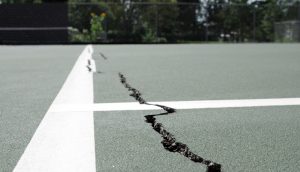City, school district debate cost split
By Scott Bellile
City and school district officials have more conversations ahead before agreeing on how to fix deteriorating tennis courts at Hatten Park.
The New London Parks and Recreation Committee on Dec. 4 voted unanimously to offer the School District of New London a proposal in which the city and the school district would split the cost 50/50 to replace four city-owned asphalt tennis courts in Hatten Park.
Each entity would pay $174,200 of the $348,400 total, which also includes 10 years of maintenance costs.
If the New London School Board declines this proposal, then the parks and recreation committee will proceed without the school district’s investment. The committee will recommend the New London City Council authorize replacing Hatten Park’s asphalt tennis courts with a tile system.
The tile system would be completely funded by the city. This approach would be cheaper for taxpayers but potentially disruptive to the New London High School tennis program.
The half-inch tile system would be installed atop the existing asphalt courts and drain water more effectively.
The cost to install a tile system and maintain it for 10 years is $190,000.

“If the courts were not used by the school district the most economical choice would be to install the tile system,” New London Public Services Director Chad Hoerth stated in a memo to the parks and recreation committee. “However since these courts are used for competition, the High School Tennis Team does not prefer the option to practice on a tile court, then play on an asphalt court at away tennis meets (and [vice] versa for teams coming to play in New London).”
Tile surfaces bounce and spin tennis balls differently than asphalt and affect tennis players’ footwork, according to a report prepared for the city last year by the Grafton-based consultant Fred Kolkmann Tennis and Sport Surfaces LLC.
Hoerth stated in his memo the school district already turned down the same 50/50 cost split proposal for replacing the asphalt courts once before.
The district had instead offered to contribute 35 percent – $100,000 – toward the $287,000 cost to replace the courts. The $287,000 does not include maintenance.
“I don’t see it being unreasonable to request a 50/50 split,” Hoerth stated in his memo, adding the school district already uses the city’s baseball diamond, softball diamonds and swimming pool at a reduced cost.
During a discussion at the Dec. 4 meeting of the parks and recreation committee, Mayor Gary Henke said, “I think our response should be 50/50 or nothing.”
“I agree, 50/50 or we go to tile,” First District Alderman John Faucher said.
Committee Chairman and Fourth District Alderman Rob Way said a tile surface would still work well for recreational play, so the city would have nothing to lose by switching from asphalt.
“We come out ahead with a nice system in the end no matter what if they don’t agree,” Way said. “I have no problem with the fallback at all if they turn it down.”
The Press Star contacted the School District of New London for comment in late December.
Business Services Director Joe Marquardt said he misunderstood the city’s proposal. He mistakenly believed Hoerth had asked the district to split the cost for a tile system 50/50.
Marquardt said he cannot speak for the school board, but it is possible the board would consider sharing the cost equally for an asphalt court replacement.
First, city officials, school officials and representatives from the tennis team must sit down and come to an agreement, including whether the tennis team would fundraise toward the cost, Marquardt said.
“The district cannot formally commit to funding until the city has the project in their budget,” Marquardt said. “I believe we are committed to doing something, it’s just when is the challenge.”
The district’s primary focus is completing facilities upgrades at six school buildings as part of the $13 million schools referendum voters passed in November, Marquardt said. Tennis courts were not part of the referendum.
“I think the great news of this is both parties are talking,” Marquardt said. “We’re trying to continue to evaluate the maintenance needs that are needed for these courts. Whether it’s students playing on them or community residents, I’m glad we’re all talking about it.”
The city’s parks and recreation committee did not hold a January meeting, so the matter will be revisited at a later date.
Tennis court evaluations by park

Scott Bellile file photo
Hatten Park’s tennis courts are in the worst shape of the courts at three New London parks, according to Hoerth.
Fred Kolkmann Tennis and Sport Surfaces LLC noted the following items in its evaluation of tennis courts at those three parks last year:
Hatten Park: Hatten Park’s issue is its tennis courts lack adequate slope to drain rainwater, especially the two southernmost courts.
Tennis court builders say courts should be as flat as possible, yet installed at enough of a slope that they can drain rainwater. Builders prefer a court that slopes side to side, angled so water drains off one of the long ends.
All together, Hatten’s four tennis courts total 1,747 square feet of low spots. These are areas where rainwater struggles to drain or evaporate.
Eighty-three percent of the problematic low spots are on the south courts.
Consultants also suggested lowering Hatten’s surrounding landscape to ease the tennis courts’ ability to drain.
The net posts and nets on the north courts are in “poor condition” because several posts are leaning.
Collectively, Hatten’s courts contain 1,425 feet of linear cracking in their structures.
On the surface, consultants reported there is peeling paint but no cracks.
Pfeifer Park: The evaluation found the courts were built incorrectly because they slope north to south – opposite of the preferred side-to-side orientation – with the high point at the net line.
The United States Tennis Association would not hold a sanctioned match on a court with such a slope, according to the evaluation.
Similar to Hatten Park, consultants suggested lowering the surrounding landscape so water could flow off the courts more efficiently.
However, Pfeifer’s courts do not have any low spots pooling water.
Pfeifer’s two courts contain a combined total of 219 linear feet of cracking in the structure.
As for the surface, consultants measured 1,400 linear feet of cracking visible on the west end, calling it “severe cracking.”
Abraham Park: Abraham Park’s courts contain a “good” drainage system. But the courts are sloped diagonally, which is not preferable, and stained in two areas from nearby trees.
The two courts have a combined total of 176 linear feet of cracking in their structure.
There were no cracks spotted on the surface.
